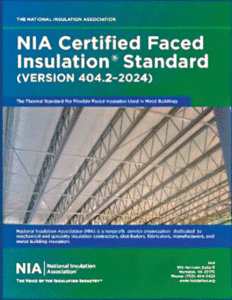
Photos courtesy Bay Insulation Systems
The metal building insulation industry has upped its game by continuing to promote research, development, testing, and updating standards. By working within various industry organizations, recent strides have been made concerning thermal performance (R-value) verification, surface burning characteristics verification, and the assurance that insulated metal buildings can comply with whole-building air leakage requirements. These efforts were undertaken to inform and assist the architectural and design communities, giving them the continued confidence to use metal building systems for current and future projects.
Metal building systems are a great solution for low-rise, non-residential construction. They can be utilized in creative ways to produce buildings that are sustainable and durable while offering minimal job site waste and faster construction times. Metal building systems are becoming more accepted within the architectural design community. According to the Metal Building Manufacturers Association (MBMA), metal building systems account for over one-third of low-rise buildings in the United States.
Fiberglass insulation and metal building systems
Architects and designers must have confidence in the products and systems they specify. Energy codes and standards, as well as safety codes and standards, play an important role in determining how products must perform. The metal building insulation industry recognizes this importance and has worked towards a solution by encouraging independent third-party certification of the performance of its products. In particular, it has focused on the thermal performance and flame spread/smoke-developed performance of laminated/faced insulation.

As a result, the National Insulation Association (NIA) recently upgraded its Standard for Laminated or Faced Metal Building Insulation. This updated standard can be found on the NIA website.1 It is free, readily available, and can be downloaded as a PDF entitled NIA Certified Faced Insulation® Standard
(Version 404.2-2024).
What has changed? To comply, metal building insulation laminators must prove that their products meet the claimed R-value and surface burning characteristics via verification by an independent third-party laboratory. It also requires that the laboratory mark(s) be placed on the product label.
For example, each insulation product label must list the stated R-value of the packaged product and the mark of the independent third-party lab that stands behind and provides certification of the stated R-value.
One example of a common mark would be the Home Innovations Laboratory mark.
Each product label must also list the surface burning characteristics of the product, being the Flame Spread/Smoke Developed values of the packaged product, as well as the mark of the independent third-party lab that stands behind and provides certification of the stated surface burning characteristics values.
One example of a common mark would be Underwriter’s Laboratories.
Fiberglass insulation systems and whole-building air leakage testing
As more state and local jurisdictions adopt the newer versions of either the American Society of Heating, Refrigeration and Air Conditioning Engineers Standard (ASHRAE) 90.1, Energy Standard for Buildings, Except Low-Rise Residential Buildings, and/or the International Energy Conservation Code (IECC), air leakage requirements are something that needs to be considered. Beginning with the 2019 version of ASHRAE 90.1 and the 2021 version of the International Energy Conservation Code (IECC), whole-building air leakage testing becomes mandatory.

In a proactive measure, the metal building insulation industry, in conjunction with the MBMA, decided to test various-sized metal building systems using various metal building insulation systems. Metal buildings, ranging in size from 232 to 3,483 m2 (2,500 to 37,500 sf), were tested and evaluated for air-leakage performance. The buildings were insulated with a variety of fiberglass insulation systems, including single-layer laminated/faced insulation, two layers of fiberglass insulation (one laminated/faced and one unfaced), two layers of unfaced fiberglass insulation with a liner system (filled cavity), and two layers of unfaced fiberglass insulation with a metal panel liner. The final results of the whole-building blower door tests concluded that these metal building systems could comply with the air-leakage requirements.
To ensure that the knowledge and experience gained as a result of the testing can be passed on to metal building system erectors and metal building insulation installers, the MBMA has published a best practices guide. The free guide, Best Practices to Comply with Whole-Building Air Leakage Testing Requirements for Metal Building Systems, can be found on the MBMA website at mbma.com.
Fiberglass metal building insulation performs extremely well in metal building systems. It has been and continues to be a very safe and cost-effective way to insulate metal building systems for all applications. Architects, designers, and specifiers can confidently use metal building systems for clients’ needs.
Notes
1 insulation.org
David Tomchak is the director of marketing at Bay Insulation Systems. With more than 30 years in the commercial construction industry, he has held engineering, sales, marketing, and general management positions.


